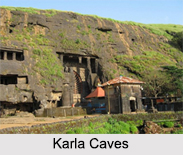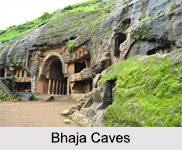 Buddhist Sculptures in Maharashtra are concentrated in places like Karla Caves, Ajanta Caves, Lonavla and Aurangabad.
Buddhist Sculptures in Maharashtra are concentrated in places like Karla Caves, Ajanta Caves, Lonavla and Aurangabad.
Maharashtra is not a state remembered for its Buddhism but rather and for its international and industrial capital, Mumbai. However, for a thousand years, the present day state of Maharashtra provided a home for Buddhism in India. Buddhist Sculptures in Maharashtra are now the tourism delight.
History of Buddhist Sculptures in India
Gautama Buddha had come from Nepal and spent much of his active life in Bihar in the eastern India. Nevertheless, after his death, Buddhism spread across to different parts of India and, for about 1,000 years, the Western Ghats Mountain Range in India were to provide support for this religion. At that time, Western Ghats are considered as the most remote area which the monks and occasionally, nuns, found more favourable for their contemplative lifestyles. For this, the Buddhist monks used to do meditation in the Western Ghats Mountain Range.
Karla Caves, Mumbai
 Karla Cave is considered as one of the most beautiful architectural and sculptural specimen of Buddhism dominance era. Karla Caves are located in the mountain ranges of Lonavala hills near Mumbai, Maharashtra. These are popularly known for rock- cut architecture and temples. Karla caves are the oldest and well maintained caves of Buddhist tradition.
Karla Cave is considered as one of the most beautiful architectural and sculptural specimen of Buddhism dominance era. Karla Caves are located in the mountain ranges of Lonavala hills near Mumbai, Maharashtra. These are popularly known for rock- cut architecture and temples. Karla caves are the oldest and well maintained caves of Buddhist tradition.
Karla Caves in 5th Century BC and its later had been one of the important centers of spiritual growth and education. These caves include one principle cave that is 15 km wide and 16km high.
Karla Caves are decorated with well carved sculptures of male and females, these caves define Buddhist art in India. Along with this, it also includes the sculptures of some animals. These are among the oldest caves of India which are saved from weather erosion.
Karla Caves maintains the sculptures of the cave in a better condition. Apart from other features, these caves are also popular for the arched roof which is supported by the wooden beams which has survived for the last 2000 years.
The entrance of Karla Cave is well decorated with choicest pillars with sculptures along with lion capitals which are similar to the lions of Ashokan pillars of Sarnath. At the entrance of the cave there is the temple of Goddess Ekveera which is considered to be a popular local pilgrimage. Karla caves also include a wooden umbrella which has been unique in these caves.
 Bhaja Caves, Pune
Bhaja Caves, Pune
Bhaja Caves are the rock-cut caves dating back to the 2nd century BC. It is located in Pune, near Lonavala, Maharashtra. Bhaja Caves are 400 feet above the village of Bhaja, on an important ancient trade route running from the Arabian Sea eastward into the Deccan Plateau. The inscriptions and the cave temple are protected as a National Monument, by the Archaeological Survey of India.
Bhaja Caves have a number of stupas, one of their significant features. The most prominent excavation is its Chaityagrha. This architectural design is demonstrating prototypes of wooden architecture and a vaulted horseshoe ceiling. Its vihara has a pillared verandah in front and is adorned with unique relief. These caves are notable for their indications of the awareness of wooden architecture. The carvings prove thattabla - a percussion instrument - was used in India for at least two thousand years. The carving shows a woman playing tabla and another woman, performing dance.
Ajanta Caves, Aurangabad District
Ajanta Caves constitute ancient monasteries and worship halls of different Buddhist traditions carved into a 250 feet wall of rock. The caves also present paintings depicting the past lives and rebirths of Gautama Buddha, pictorial tales from Aryasura`s Jatakamala, as well as rock-cut sculptures of Buddhist deities in vogue between the 2nd century BC and 5th century CE.
The textual records suggest that caves of Ajanta Caves served as a monsoon retreat for monks, as well as a resting site for merchants and pilgrims in ancient India. While vivid colours and mural wall painting were abundant in Indian history as evidenced by historical records, Caves 16, 17, 1 and 2 of Ajanta form the largest corpus of surviving ancient Indian wall-painting.



